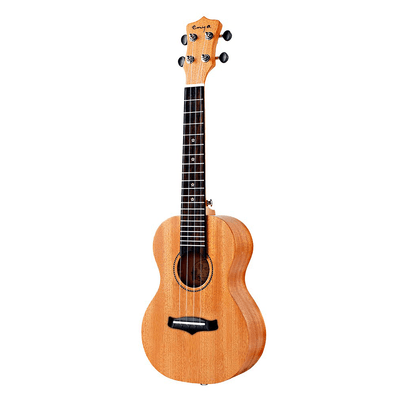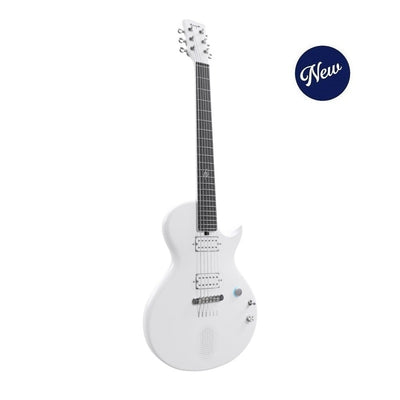Low G Tuning

If you’ve been playing the ukulele for a little while now — or even if you’re just looking into buying your first uke — chances are you’ve come across something called “low G tuning”. But what is it, exactly? In this article, we’re going to answer that question and more — including how low G tuning compares to traditional ukulele tuning and the benefits of using it — so that you can decide if it’s right for you.
LOW G VS. HIGH G TUNING
When talking about low G and high G tuning, the “G” refers to the G-string on your ukulele (the 4th string; the one closest to your head when you are playing). Ukuleles are one of the few instruments to use a tuning method called re-entrant tuning, which means that the strings are not organized from the lowest pitch to highest pitch (like they are on a guitar or a piano, for example). Traditionally, ukuleles are tuned to the notes GCEA, with the C-string being the lowest note, and the G-string being the second-highest note despite being the bottom string (so, if the strings were organized by their pitch from lowest to highest, the order would be CEGA). Since the G-string is higher in pitch than the C-string, this is known as “high G” tuning.
By contrast, low G tuning is when the G-string is lower in pitch than the C-string, so that the strings are organized from the lowest pitch on the bottom to the highest pitch on the top. To do this, the G-string is tuned an octave down from where it normally is on a high G ukulele. You’ll often see the notes of high G tuning written out as “gCEA” and those of low G written as “GCEA”.
Most ukulele players would agree that high G tuning best represents the way a traditional ukulele sounds. The high G-string gives it the bright, happy sound that is generally what people associate with the instrument. A ukulele tuned to low G, on the other hand, has a bit of a warmer, mellower sound. Even though it veers a little bit away from the traditional ukulele sound, there are several benefits to using low G tuning, and many ukulele players actually prefer it over high G tuning.
THE BENEFITS OF LOW G
The main benefit to using low G tuning is the range of notes you are able to play. In short, low G tuning allows you to play a wider range of notes than high G tuning. On a traditional 12-fret soprano ukulele using gCEA tuning, the lowest note you can play is a C4 and the highest note is an A5, meaning you have 1 ¾ octaves to work with. With a low G-string, that same ukulele would now give you a range of 2 ⅙ octaves, from G3 to A5. Having a wider range of notes to work with is especially useful for ukulele players who like to play melodies, solos, etc. Personally, I like to arrange instrumental covers on the ukulele, and am often figuring out how to play parts that were written for guitar, which has a range of roughly 4 octaves. By using low G tuning and having that wider range of notes at my disposal, I am able to arrange the songs much more accurately on the ukulele.
The other benefit of using low G tuning is that it makes the chords you play sound more full and warm overall, since you’re adding more depth with the lower G-string. However, removing the high G-string does sacrifice some of the brightness associated with the traditional ukulele sound, so you’ll have to decide which sound you prefer.
IS LOW G RIGHT FOR YOU?
Now that you’ve learned all about low G tuning, you can decide whether or not you think it’s right for you. Keep in mind that neither tuning is objectively better than the other — it all boils down to your personal preference. Do you prefer the bright and happy sound of a traditional high G ukulele, or would you rather hear a mellow and warm sound more akin to a small guitar? Do you like to play melodies and solos on the ukulele and think the expanded range of notes could be helpful?
If you’re a beginner and shopping for your first ukulele, I’d recommend holding off on low G tuning for now and going with high G as it is the more traditional tuning. However, if you’re a guitar player looking to pick up the ukulele, you might actually find it easier to learn using low G tuning since you’ll be more accustomed to the strings being organized from lowest pitch to highest pitch. If you’ve been playing ukulele for some time now and haven’t tried out low G tuning yet, I’d definitely recommend at least giving it a shot and seeing if you enjoy the expanded range of notes and warmer sound.
HOW TO GET STARTED WITH LOW G
If you’ve decided to give low G tuning a shot, great! There are two options for getting started, depending on what you already have and what your budget is.
Option 1: Buy New StringsIf you already have a high G ukulele, the most affordable option for switching to low G tuning is buying new strings. Unfortunately, you can’t simply tune a high G-string down an octave to switch to low G (I mean, you could try, but the string will be super loose and won’t sound very good). Instead, you’ll want to get a new set of strings that are labeled as “Low G” — this just means that the G-string is an octave lower; all the other strings are the same as normal. You can also get a single low G-string, but I’d recommend changing all four of your strings at the same time if you are able to. The low-G string comes in two options — wound or unwound. Traditionally, ukulele strings are unwound. A wound string is wrapped in a thin coil of steel wire and sounds louder than a regular unwound string. Many low G ukulele players prefer the sound of the wound G-string as it gives more emphasis and definition to the lower notes being played.
Additionally, a low G-string is thicker than a traditional high G-string. This means that if your ukulele is currently set up for high G tuning, you may need to widen the 4th string’s slot on the nut (the little plastic piece between the headstock and the neck that holds the strings in place) in order for the low-G string to fit. If you have a small file, this is a relatively simple adjustment that you can make at home. However, keep in mind that once you widen the nut slot, you can’t go back (unless you buy a new nut).
Option 2: Buy A New UkuleleThe second option is to buy a new ukulele that’s set up for low G tuning. Obviously, this isn’t as affordable as simply changing your strings, but there are plenty of affordable low G ukuleles out there, and you’ll be able to find one within your price range. Having two ukuleles — one high G and one low G — gives you the best of both worlds and allows you to switch between tunings whenever you’d like. If you have the funds, I would recommend going with this option.
Whichever option you choose, I hope your journey into the world of low G tuning brings you all sorts of new joy and expands your love for the ukulele. Happy uke-ing!









